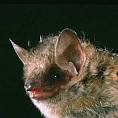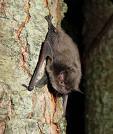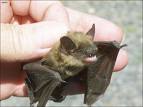| Eastern Pipistrelle - Pipistrellus Subflavus |

|
Eastern
Pipistrelle - Pipistrellus Subflavus
|
Common Name: |
Eastern pipistrelle |
|
Scientific Name: |
Pipistrellus subflavus |
|
Range: |
Throughout east coast of North America to northern South
America |
|
Habitat |
Edges of forests and agriculture or watercourses |
The Eastern pipistrelle
is one of the 15 species of bats found in Ohio. It is also one of the smallest bats in the east growing up to 3.5" long with
a wings span of up to 10" and they can weigh up to 1/4 of an ounce.
Mostly found roosting under loose bark or in the cavity
of a tree. However, they will also be found in buildings. In the winter time they either hibernate living off of stored fat,
or they migrate to warmer climates where food is still available. Eastern pipistrelles feed on insects, especially leafhoppers,
plant hoppers, moths, beetles, and flies. Usually hunting above the tree canopy they are one of the first bats to emerge in
the evening. They find their food using echolocation. Bats are the only members of the mammal family that can fly. Like all
mammals they have fur and are warm blooded. They also give live birth and produce milk for their babies. Bats are in the scientific
order Chiroptera (kie-rop-ter-a), which means 'hand-wing' and are known to live from 10 to 32 years. While most people generally
think of bats living in caves, in the summer time bats actually live behind bark, in tree's, jungles, and man made structures
such as buildings, barns, and bridges. Bats provide an extremely important service for the environment in that they eat large
quantities insects. In fact some bats can eat as many as 1,200 insects in one hour. Since some insects such as misquotes carry
diseases including the West Nile Virus and other insects like Cucumber Beatles and moths can cause severe crop damage, bats
are doing humans a huge favor as well
| Evening Bat - Nycticeius |

|
Evening
Bat - Nycticeius
|
Common Name: |
Evening Bat |
|
Scientific Name: |
Nycticeius humeralis |
|
Range: |
Eastern US |
|
Habitat |
|
The Evening Bat is one of the 15 species of bats found in Tennessee
and also Ohio. Adults grow to about 4 inches, have a wing span of 11 inches, and weigh about 1/4 ounce.
Evening Bats are
insectivore eating mostly flying insects. Usually hunting above the tree canopy they are one of the first bats to emerge in
the evening. They find their food using echolocation. Bats are the only members of the mammal family that can fly. Like all mammals they have fur
and are warm blooded. They also give live birth and produce milk for their babies. Bats are in the scientific order Chiroptera
(kie-rop-ter-a), which means 'hand-wing' and are known to live from 10 to 32 years.
| Hoary Bat - Lasiurus Cinereus |

|
Hoary bat - Lasiurus
Cinereus
|
Common Name: |
Hoary bat |
|
Scientific Name: |
Lasiurus cinereus |
|
Range: |
Most of North and Central America |
|
Habitat |
Any |
The Hoary bat is one of the largest bats in North America growing
up to 5" long with a wingspan of up to 16". They can weigh up to 1 ounce. The Hoary bat is the only native land mammal from
Hawaii. Mostly found roosting in a tree. However they will also utilize caves and cracks in rocks. Hoary bats are insectivore
so they only eat insects. Including moths, mosquitoes, and wasps. Usually hunting above the tree canopy they emerge after
dark. They find their food using echolocation. Bats are the only members of the mammal family that can fly. Like all mammals
they have fur and are warm blooded. They also give live birth and produce milk for their babies. Bats are in the scientific
order Chiroptera (kie-rop-ter-a), which means 'hand-wing' and are known to live from 10 to 32 years.While most people generally
think of bats living in caves, in the summer time bats actually live behind bark, in tree's, jungles, and man made structures
such as buildings, barns, and bridges. Bats provide an extremely important service for the environment in that they eat large
quantities insects. In fact some bats can eat as many as 1,200 insects in one hour. Since some insects such as misquotes carry
diseases including the West Nile Virus and other insects like Cucumber Beatles and moths can cause severe crop damage, bats
are doing humans a huge favor as well.
| Indiana Bat - Myotis Sodalis |

|
Indiana Bat -
Myotis Sodalis
|
Common Name: |
Indiana Bat |
|
Scientific Name: |
Myotis sodalis |
|
Range: |
Eastern US |
|
Habitat |
|
The Indiana Bat is one of the 15 species of bats found
in Ohio. Adults grow to about 3 inches, have a wing span of 10 inches, and weigh about 1/4 ounce. The Indiana Bat is on the
U.S. Endangered Species List
and classified as endangered throughout its range. States where they are found include AL, AR, GA,
IA, IL, IN, KS, KY, MD, MI, MO, MS, NC,
NJ, NY, OH, OK, PA, SC,
TN,
VA, VT, WV. Indiana Bats are insectivore eating mostly flying insects. Usually hunting above the tree canopy they are one
of the first bats to emerge in the evening. They find their food using echolocation. Limestone caves are used for winter hibernation. The following
caves are considered Critical habitat in the Southeast: White Oak Blowhole Cave (Blount, TN); Bat Cave (Carter, KY); Coach
Cave (Edmonson, KY). Bats are the only members of the mammal family that can fly. Like all mammals they have fur and are warm
blooded. They also give live birth and produce milk for their babies. Bats are in the scientific order Chiroptera (kie-rop-ter-a),
which means 'hand-wing' and are known to live from 10 to 32 years. While most people generally think of bats living in caves,
in the summer time bats actually live behind bark, in tree's, jungles, and man made structures such as buildings, barns, and
bridges.
| Little Brown Bat - Myotis Lucifugus |

|
Little Brown Bat
- Myotis Lucifugus
|
Common Name: |
Little Brown Bat |
|
Scientific Name: |
Myotis lucifugus |
|
Range: |
Forested areas of North America |
|
Habitat |
forest areas, often form maternity colonies in buildings,
attics etc.. |
The Little Brown Bat is
one of the 15 species of Bats found in Ohio. Adults grow to about 3.5 inches, have a wing span of 10 inches, and weigh about
1/4 ounce. Little Brown Bats are insectivore eating mostly flying insects. Including beetles, wasps, bees, flies and more.
Usually hunting above the tree canopy they are one of the first bats to emerge in the evening. They find their food using
echolocation. Bats are the only members of the mammal family that can fly. Like all mammals they have fur and are warm blooded.
They also give live birth and produce milk for their babies. Bats are in the scientific order Chiroptera (kie-rop-ter-a),
which means 'hand-wing' and are known to live from 10 to 32 years. While most people generally think of bats living in caves,
in the summer time bats actually live behind bark, in tree's, jungles, and man made structures such as buildings, barns, and
bridges. Bats provide an extremely important service for the environment in that they eat large quantities insects. In fact
some bats can eat as many as 1,200 insects in one hour. Since some insects such as misquotes carry diseases including the
West Nile Virus and other insects like Cucumber Beatles and moths can cause severe crop damage, bats are doing humans a huge
favor as well.
|

